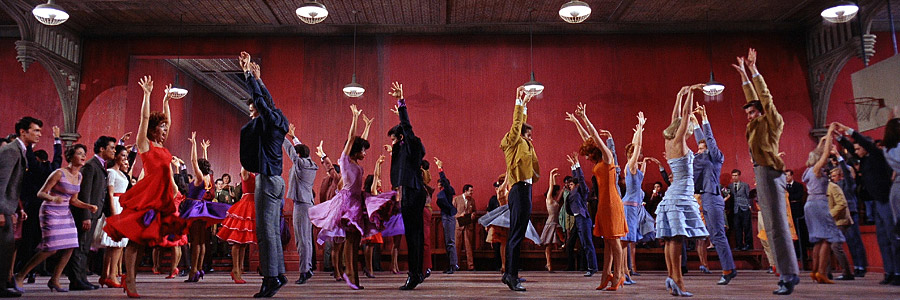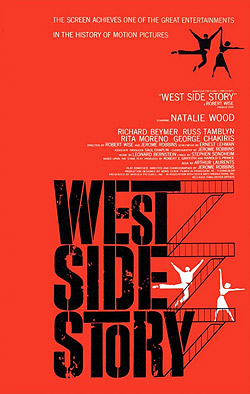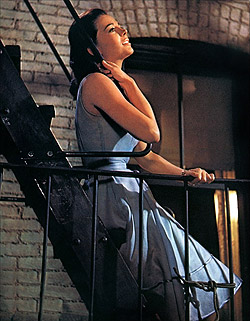
West Side Story

WEST SIDE STORY (MOVIE)
United Artists
Original release: October 18th, 1961
Running time: 152 minutes
Directors: Robert Wise, Jerome Robbins
Writer: Ernest Lehman
Music: Leonard Bernstein, Stephen Sondheim
Cast: Natalie Wood, Richard Beymer, Russ Tamblyn, George Chakiris

Whether it’s the finger-snapping, toe-tapping musical numbers, the frantic choreography, the bursting colour of the outfits or the energetic spin it gives to Shakespeare’s Romeo and Juliet there’s something for us all to love about West Side Story, and love it we do, decade after decade. It’s the classic story of a love affair between Tony (Richard Beymer) and Maria (Natalie Wood), with the backdrop of a gang war between the Jets and the Sharks. The lovers are caught on opposite sides with Maria being the sister of Bernardo (George Chakiris), the leader of the Sharks, and Tony being the best friend of Riff (Russ Tamblyn), the leader of the Jets.
With the American teenagers pitted against the Puerto Rican immigrants, West Side Story is also about the gap between the haves and have-nots, about overcoming prejudices, social divides and deeply rooted racist sentiments which were rife in America at the time. As the lovers are drawn closer to each other, the violence around them threatens to tear them apart, as with the Montagues and the Capulets in Romeo and Juliet. The only thing they can do is try to unite both sides and get them to see reason; that hate only leads to more hate.
When Tony heads down to intervene during another senseless and frustrating conflict between the Jets and Sharks it inadvertently leads to more bloodshed on the streets of New York until finally it’s Maria’s heartbreaking speech that brings the war to an end. West Side Story is still a force to be reckoned with and its influence can still be felt today. Barry Keith Grant sheds some light on what New York was like during that time and the success the film had:

He then goes on to tell us about that editing style of the film and what kind of impact it had on popular culture in the decades that followed.
This is certainly true. For example, there’s clearly a difference when we look at the musical numbers in Seven Brides For Seven Brothers (1954), Guys And Dolls (1955) and The King And I (1956) and compare them with Dance at the Gym, Gee, Officer Krupke, or Cool. The editing goes much faster, there are more close-ups on the action rather than long-shots and overall it really moves with the beat. Grant then goes on to say:
Can we really go that far as to alluding to West Side Story as an influence for the pop music videos of the 1980’s? Of course we can. Music videos from this time occasionally showcased an ensemble of rival groups and dance-offs, Michael Jackson’s Beat It and Bad are prime examples of this. David Winters, a dancer and choreographer who appeared both in the stage version and the film adaptation of West Side Story, playing A-rab, remembers meeting Michael Jackson when he worked on a television special with him and Diana Ross:
- Barry Keith Grant, The Hollywood Film Musical (2012), Wiley-Blackwell [1]
- David Winters remembers Michael Jackson [2]
Michael’s videos would in turn influence a new generation, ensuring that West Side Story would live on through him.
From its music by Leonard Bernstein and lyrics by Stephen Sondheim which fused together jazz, Latin and classical elements to create an unforgettable soundtrack, to its fashion and choreography West Side Story will quite simply never be forgotten.


Patrick Samuel
The founder of Static Mass Emporium and one of its Editors in Chief is an emerging artist with a philosophy degree, working primarily with pastels and graphite pencils, but he also enjoys experimenting with water colours, acrylics, glass and oil paints.
Being on the autistic spectrum with Asperger’s Syndrome, he is stimulated by bold, contrasting colours, intricate details, multiple textures, and varying shades of light and dark. Patrick's work extends to sound and video, and when not drawing or painting, he can be found working on projects he shares online with his followers.
Patrick returned to drawing and painting after a prolonged break in December 2016 as part of his daily art therapy, and is now making the transition to being a full-time artist. As a spokesperson for autism awareness, he also gives talks and presentations on the benefits of creative therapy.
Static Mass is where he lives his passion for film and writing about it. A fan of film classics, documentaries and science fiction, Patrick prefers films with an impeccable way of storytelling that reflect on the human condition.
© 2022 STATIC MASS EMPORIUM . All Rights Reserved. Powered by METATEMPUS | creative.timeless.personal. | DISCLAIMER, TERMS & CONDITIONS
HOME | ABOUT | CONTACT | TWITTER | GOOGLE+ | FACEBOOK | TUMBLR | YOUTUBE | RSS FEED
CINEMA REVIEWS | BLU-RAY & DVD | THE EMPORIUM | DOCUMENTARIES | WORLD CINEMA | CULT MOVIES | INDIAN CINEMA | EARLY CINEMA
MOVIE CLASSICS | DECONSTRUCTING CINEMA | SOUNDTRACKS | INTERVIEWS | THE DIRECTOR’S CHAIR | JAPANESE CINEMA





